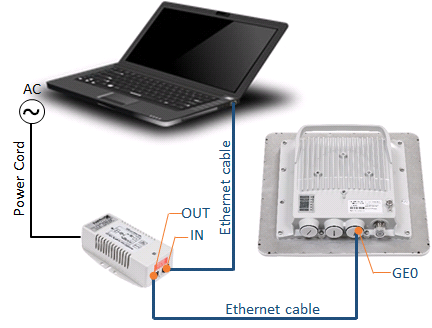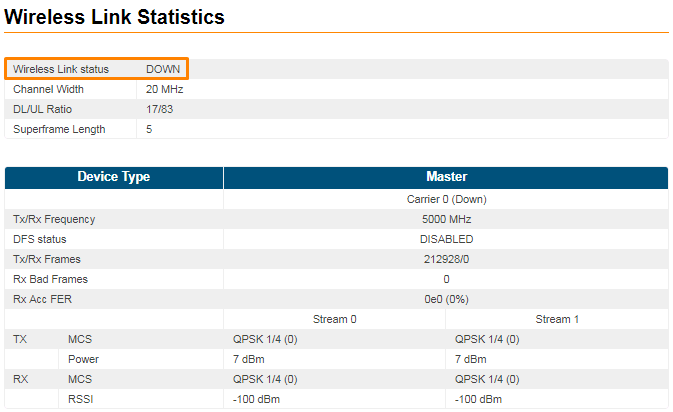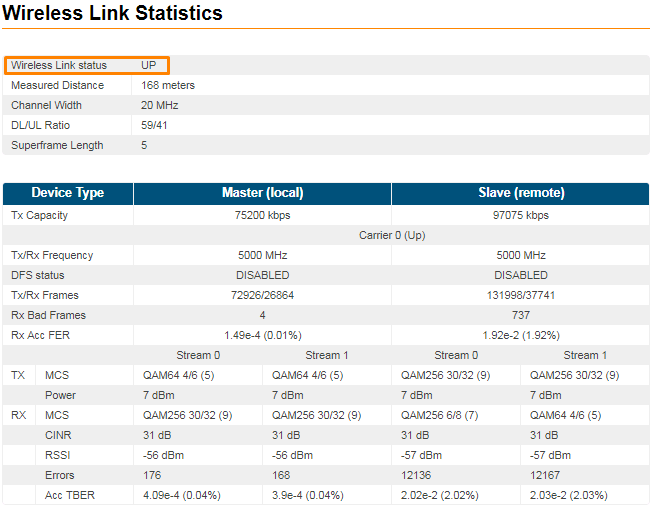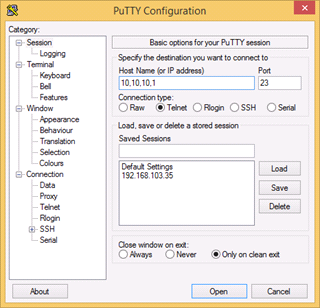| Metadata (Metadata Plugin) |
|---|
|
Laboratory pre-configuration |
...
| Center |
|---|
| Scroll Title |
|---|
| title | Figure- Connection Scheme |
|---|
| 
|
|
| Warning |
|---|
|
Before supplying power to the Um models an external antenna or RF terminators with 50 Ohms resistance must be connected to both N-type connectors. During laboratory testing, it is allowed to directly connect two devices with RF cables without antennas with the mandatory use of attenuators with attenuation of at least 40 dB for each polarization. Switching off/on the attenuators and RF cables should only be performed when the devices are in the off state. In case the antenna, attenuator or terminator is connected to only one N-type connector do not switch on the device. PLEASE NOTE THAT VIOLATION OF THE ABOVE REQUIREMENTS VOIDS THE WARRANTY. |
After the physical connections are completed, configure each unit as described below.
...
Settings via web interface
| Anchor |
|---|
| Settings via web interface |
|---|
| Settings via web interface |
|---|
|
| Step 1 |
|---|
Access the unit to the default IP address 10.10.10.1 with mask 255.255.255.0 via web browser. Make sure that the Ethernet port of the Laptop has an IP address assigned from the same subnetwork as the one for the unit (for example, set 10.10.10.50 with mask 255.255.255.0). |
| Step 2 |
|---|
Use any letters or numbers for initial authentication, for example: - User name: "login".
- Password: "password".
| Note |
|---|
| Make sure to set strong passwords before running the units in production. |
|
| Step 3 |
|---|
Log in to the Web GUI. Initially the status of the radio link is DOWN like below. | Center |
|---|
| Scroll Title |
|---|
| title | Figure - Initial link status |
|---|
|  Image Modified Image Modified |
|
|
| Step 4 |
|---|
Upgrade the units to the latest stable firmware version.
|
| Step 5 |
|---|
Perform radio settings. Go to the "Radio" section and set the following parameters: - Node Type (one unit must be set to Master and the other one to Slave).
- Link ID.
- Channel Width.
- Frame period.
- Max Distance.
- Center Frequency.
- Maximal Transmit Power.
| Note |
|---|
| The detailed description for each radio setting can be found in the section "Radio". |
| Warning |
|---|
| Please note that the following parameters must have the same values at each of the two units in the PtP link. Otherwise the wireless link won’t be established: - Center Frequency
- Channel Width
- Frame Period
- Max Distance
- Short Cyclic Prefix
- Link ID
|
|
| Step 6 |
|---|
Save the configuration, reboot both units and check if they link is up. The link status should be UP and the radio statistics should indicate the capabilities and quality of the link. | Center |
|---|
| Scroll Title |
|---|
| title | Figure - Link UP status |
|---|
|  Image Modified Image Modified
|
|
|
Settings via CLI
| Anchor |
|---|
| Settings via CLI |
|---|
| Settings via CLI |
|---|
|
| Step 1 |
|---|
CLI is available via telnet: "cmd> telnet 10.10.10.1" or use any suitable telnet client such as Putty. | Center |
|---|

|
|
| Step 2 |
|---|
Use any letters or numbers for initial authentication, for example: - User name: "login".
- Password: "password".
| Note |
|---|
|
Make sure to set strong passwords before running the units in production. |
|
| Step 3 |
|---|
Check the firmware version and upgrade the units to the latest stable firmware version. You can check firmware version via command: | Code Block |
|---|
| language | powershell |
|---|
| theme | Emacs |
|---|
| xginfo version |
Compare current version of the unit with version on official InfiNet Infinet ftp server: ftphttps://ftp.infinet.ru/pub/Firmware/XG/H12. In case a newer version is available we recommend upgrading.
|
| Step 4 |
|---|
Configure radio parameters. | Center |
|---|
| Parameter | Command | Value (example) |
|---|
| Node Type | xg -type | master (slave) | | Link ID | xg -cell-id | 1 | | Channel Width | xg -channel-width | 40 | | Frame period | xg -sframelen | 5 | | Max Distance | xg -max-distance | 1 | Downlink Center Frequency
| xg -freq-dl | 4960 | Uplink Center Frequency
| xg -freq-ul | 5010 | Maximal Transmit Power
| xg -txpwr | 10 |
|
| Warning |
|---|
| Please note that the following parameters must match at both units. Otherwise the wireless link won’t be established: - Center Frequency
- Channel Width
- Frame Period
- Max Distance
- Short Cyclic Prefix
- Link ID
|
| Note |
|---|
| In order to apply the same settings to the another unit you should use the following command output "xg config -peer-exported". Execute these commands in CLI of the another unit. | Code Block |
|---|
| language | javatext |
|---|
| theme | DJangoEmacs |
|---|
| #Peer exported config:
xg -v3-start
xg -v3 a01b833402f59907abdcb812d5de20fd.Ko7ClHTRVps/8oyNjnucBcSqUlcCJbOae9Kf4OZ
xg -v3 zRU7tYm1REMTUyHWYTaGGuuooDp2DWkcxyFGLmEb5yx45wFImL5Nx72XK6bnl9AzRdZjWVSN
xg -v3 xCrliSUfn7JZazn1yTEKE90fKLIK/HKNJXYN7vg4lEocgBWguYdFc/u8fEwENtJYBSKNGbu3
xg -v3 HQ0HvIdTqAwOz5vXM89CkhL5ZZmDuYN3FFSo6wV+h//zBuSfuJ5QVb6fv2Do6tPIE4kuZSsB
xg -v3 UXLavUriPtSlRxzIYUO7+9XSMggomrf7NZtM37PxQkUYIZ116K3++w5HPVXXq8Po7xVmotnq
xg -v3 px1uDbYtSjs2O9yx6h6Z0HGp8GLAEY7Ka5ZRoyAvyfA73pobYrEhzZ+hdwWnDDJYM3DmAhuW
xg -v3 yAUgtVHJ4hC9u6BP5IAlQXsm5QSbuRwihWdmrwiThwSGmXiZWCXOmxzg1IA==
xg -v3-end |
|
|
| Step 5 |
|---|
Save configuration. | Code Block |
|---|
| language | powershell |
|---|
| theme | Emacs |
|---|
| config save |
|
| Step 6 |
|---|
Restart the unit. | Code Block |
|---|
| language | powershell |
|---|
| theme | Emacs |
|---|
| restart yes |
|
| Step 7 |
|---|
Check the link status. | Code Block |
|---|
| language | powershell |
|---|
| theme | Emacs |
|---|
| Sys log show | grep UP |
In case of success configuration: | Code Block |
|---|
| language | powershell |
|---|
| theme | Emacs |
|---|
| [XG]: changed state UP->DOWN |
|
...



